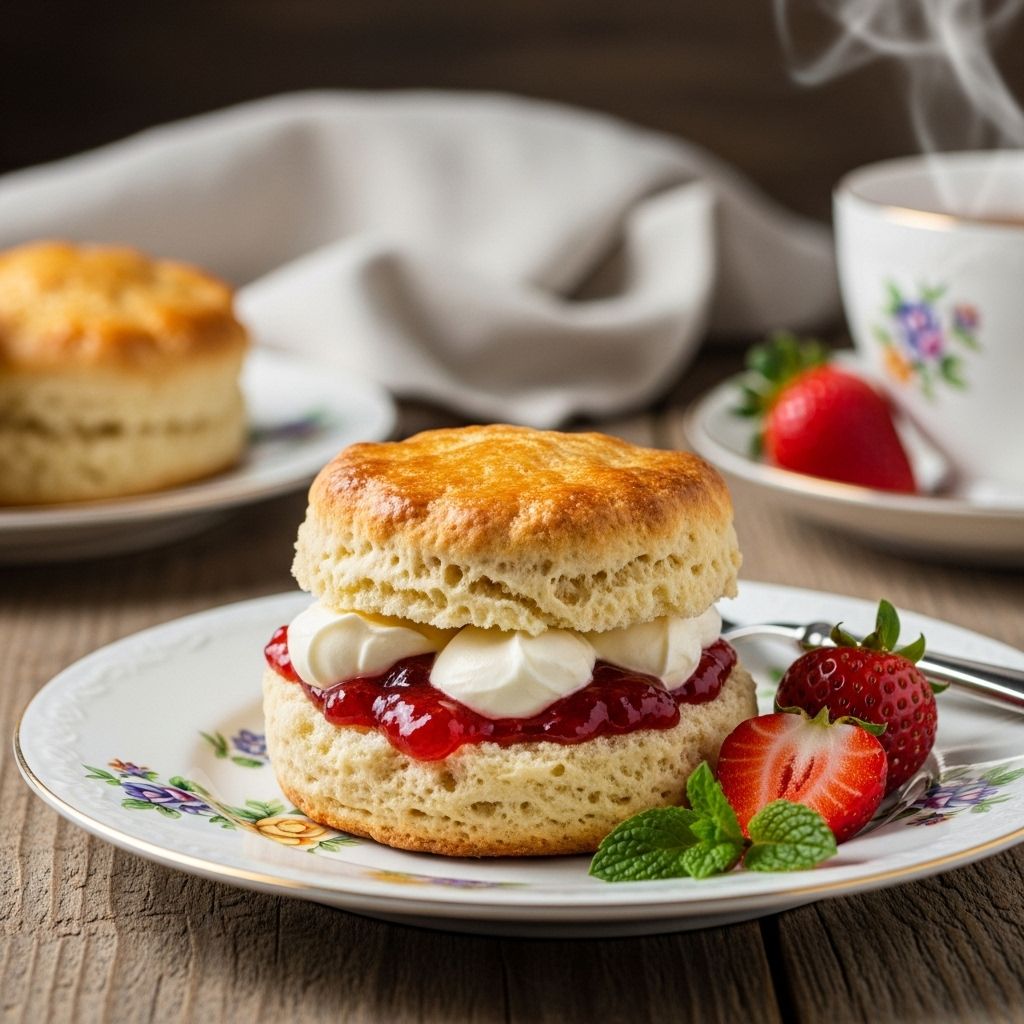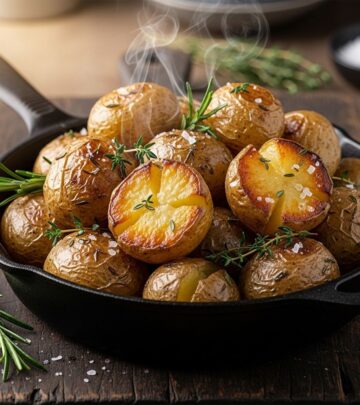Easy Scone Recipe: 6 Expert Tips For Perfect Classic Scones
Discover the secrets to baking soft, rich, golden scones at home with this foolproof recipe and expert baking tips.

Image: HearthJunction Design Team
Simple Scones: The Ultimate Guide to Making Perfect Classic Scones at Home
Scones are a classic treat beloved by many for their light crumb, buttery richness, and versatility at the breakfast table or afternoon tea. In this comprehensive guide, you’ll learn the history, ingredients, step-by-step instructions, essential baking tips, delicious variations, serving suggestions, storage advice, and answers to frequently asked questions about making the perfect simple scones from scratch.
Table of Contents
- Introduction to Scones
- Ingredients for Simple Scones
- Step-by-Step Instructions
- Expert Tips for the Best Scones
- Scone Variations and Mix-Ins
- Serving Suggestions
- How to Store and Freeze Scones
- Nutrition Facts
- Frequently Asked Questions (FAQs)
Introduction to Scones
Scones are a staple in British baking, cherished for their crumbly-yet-moist texture and simple, comforting flavor. Traditionally served with clotted cream and jam, scones have become a worldwide favorite, often appearing at brunches, tea parties, and cozy breakfasts. This guide will teach you the easiest way to make classic sweet scones using pantry staples and a few professional techniques.
Ingredients for Simple Scones
To create the best scones, start with high-quality basics. Here’s what you’ll need for a standard batch (yields approximately 8 scones):
- 2 cups all-purpose flour
- 1/3 cup granulated sugar
- 1 teaspoon baking powder
- 1/2 teaspoon salt
- 1/4 teaspoon baking soda
- 8 tablespoons (1 stick) unsalted butter, cold and cubed
- 1/2 cup sour cream
- 1 large egg
Optional Mix-Ins: Add dried fruits (such as raisins, currants, or cranberries), orange or lemon zest, or chocolate chips for extra flavor and texture.
Step-by-Step Instructions
- Preheat the Oven: Set your oven to 400°F (200°C). Prepare a baking sheet by lining it with parchment paper or lightly greasing it.
- Mix the Dry Ingredients: In a large bowl, whisk together the flour, sugar, baking powder, salt, and baking soda. This ensures even distribution of leavening agents and salt.
- Cut in the Butter: Add the cold, cubed butter to the dry ingredients. Using a pastry blender, two forks, or your fingertips, cut the butter into the flour mixture until it resembles coarse crumbs. Small bits of intact butter help create flakiness in the scone.
- Combine Wet Ingredients: In a separate small bowl, whisk together the sour cream and egg until smooth.
- Make the Dough: Add the wet mixture to the dry mixture. Use a spatula or wooden spoon to gently incorporate the ingredients until just combined; do not overmix.
- Add Mix-Ins (Optional): Fold in dried fruit, zest, or chocolate chips if desired.
- Shape the Dough: Turn the dough onto a lightly floured surface. Knead gently just until it comes together. Pat into a ¾-inch thick round, about 7-8 inches in diameter.
- Cut the Scones: Use a sharp knife or bench scraper to cut the dough into 8 triangles (like a pizza). Transfer the scones to the prepared baking sheet, spacing them at least 2 inches apart.
- Bake: Bake for 15-17 minutes, or until the scone tops are golden and firm to the touch. Remove to a wire rack to cool slightly before serving.
Expert Tips for the Best Scones
- Use Cold Butter: The colder the butter, the flakier the scone. Consider chilling flour and mixing bowl for best results.
- Do Not Overwork the Dough: Overmixing develops gluten, making scones dense and tough. Mix until ingredients just come together.
- Pat, Don’t Roll: Gently pat the dough into shape. Overhandling compresses the dough and reduces rise.
- Spacing: Place scones far enough apart on the baking sheet so that hot air circulates and each can rise fully.
- Brushing the Tops: For added color and crunch, brush the scones with heavy cream, milk, or a lightly beaten egg before baking, and sprinkle with coarse sugar.
- Serve Warm: Scones are most delightful fresh and slightly warm from the oven.
Scone Variations and Mix-Ins
Once you’ve mastered the basic scone recipe, experiment with your favorite flavor combinations. Here are some popular ideas:
- Fruit Scones: Add 1 cup of dried cranberries, sultanas, cherries, or raisins.
- Citrus Scones: Add 1 tablespoon each of lemon or orange zest and drizzle with a simple citrus glaze after baking.
- Chocolate Chip Scones: Stir in 3/4 cup of semi-sweet or white chocolate chips.
- Spiced Scones: Add 1 teaspoon ground cinnamon, 1/2 teaspoon nutmeg, and a pinch of cloves.
- Savory Scones: Swap sugar for a pinch of black pepper and fresh herbs, and add 1/2 cup grated sharp cheese (e.g., cheddar).
Sample Scone Variation Table
| Variation | Main Add-Ins | Flavor Profile |
|---|---|---|
| Classic | None | Simple, buttery, slightly sweet |
| Fruit | Dried currants, raisins, cranberries | Sweet and tangy |
| Citrus | Lemon zest, orange zest, glaze | Zesty and refreshing |
| Chocolate | Chocolate chips | Rich and decadent |
| Savory | Herbs, cheese, cracked pepper | Earthy and robust |
Serving Suggestions
- Enjoy warm scones with clotted cream, whipped butter, or mascarpone and a generous spoonful of strawberry or raspberry jam.
- For breakfast, pair scones with fresh fruit, a cup of tea, or coffee.
- Offer at gatherings stowed in a bread basket lined with a linen napkin to keep them warm.
- Scones make a thoughtful addition to brunch spreads and special occasions like Mother’s Day or baby showers.
How to Store and Freeze Scones
Scones are best eaten the day they are made, but leftovers can be stored for later enjoyment:
- Room Temperature: Store cooled scones in an airtight container for up to 2 days.
- Freezing: Place cooled scones in a freezer-safe bag or container. Freeze for up to 2 months. Thaw overnight at room temperature and reheat in the oven for a few minutes to refresh.
- Reheating: Warm scones in a 300°F (150°C) oven for 5–10 minutes to restore their texture and flavor.
Nutrition Facts
Nutritional content will vary depending on mix-ins and portion size, but a typical basic scone (without add-ins) contains approximately:
- Calories: 220–250 per scone
- Total Fat: 10–12g
- Saturated Fat: 6–7g
- Cholesterol: 45–55mg
- Sodium: 260–280mg
- Total Carbohydrates: 30–34g
- Protein: 4–5g
Adding fruit, chocolate, or glaze will adjust the nutritional values.
Frequently Asked Questions (FAQs)
What is the secret to moist and tender scones?
The key is to use cold butter and avoid over-mixing the dough. Sour cream helps add moisture and tenderness, resulting in a soft crumb with a rich flavor.
Can I use yogurt instead of sour cream?
Yes! Plain full-fat yogurt can replace sour cream in this recipe, although it will slightly alter the flavor and texture.
Why do my scones turn out dry?
Dry scones are usually the result of over-baking, over-mixing, or using too little fat. Be sure to check for doneness at the minimum time and keep the dough as moist as possible without being sticky.
Can I make scones in advance?
Absolutely. Shape the scones, place them on a baking tray, and freeze until firm. Transfer to a freezer bag. Bake directly from frozen, adding 2-3 extra minutes to the baking time.
How do I achieve a crisp top and soft interior?
Brush scones with cream or egg wash before baking for a golden, crisp top. Do not overbake, and serve fresh for the softest results.
What is the best way to cut scones?
Use a sharp, floured knife or a bench scraper. For round scones, a floured biscuit cutter works best. Press straight down without twisting for even rising.
Conclusion
With this simple, reliable recipe and a few expert tips, anyone can produce bakery-quality scones at home. Whether enjoyed plain, studded with fruit, or generously glazed, scones offer endless possibilities for creative baking and sharing with family and friends. Start with this foundation and make it your own—delicious, warm, and comforting every time.
References
- https://www.allrecipes.com/recipe/79470/simple-scones/
- https://www.allrecipes.com/recipe/20175/scones/
- https://www.allrecipes.com/recipe/20163/grandma-johnsons-scones/
- https://www.allrecipes.com/recipe/85629/worlds-best-scones-from-scotland-to-the-savoy-to-the-us/
- https://www.youtube.com/watch?v=drp13MZMYMk
Read full bio of Shinta












